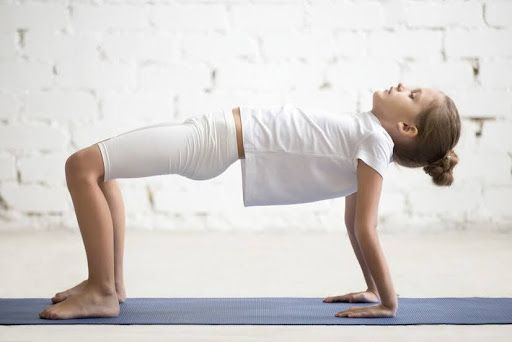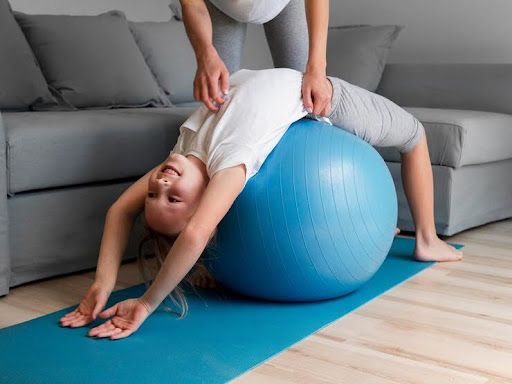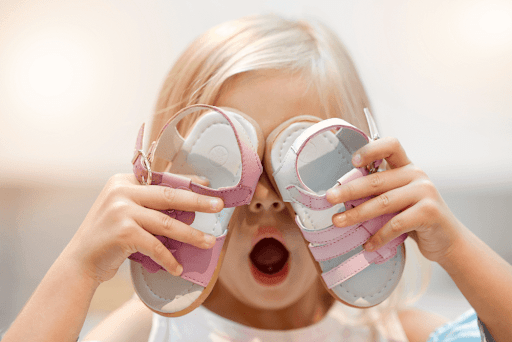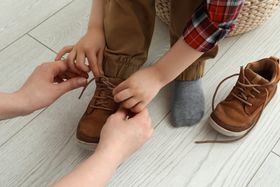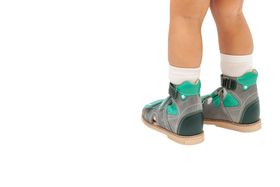8 Best Ways to Improve Your Child's Posture: For Confidence & Health
Straighten up! Simple steps to improve your child's posture & boost their confidence.
Published January 12, 2025.
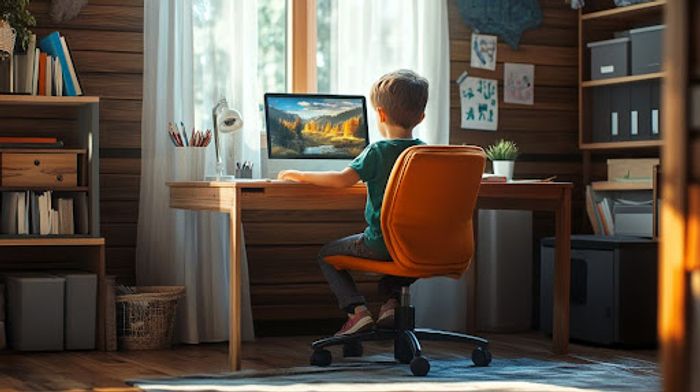
Good posture isn't just about standing up straight—it's a foundation for your child's physical health, confidence, and overall well-being. As parents, we often notice our children slouching over devices or carrying heavy backpacks, but we may not realise the long-term impact these habits can have.
Poor posture during childhood can lead to muscle imbalances, spine problems, and even affect self-esteem. The good news is that there are proven strategies to help improve your child's posture, and it's never too early (or late) to start.
» Invest in shoes to promote good posture at every stage of development
Why Posture Matters
Poor posture during childhood can lead to various issues, from immediate discomfort to long-term health problems. Children with poor posture often experience muscle fatigue, decreased mobility, and even neck, shoulders, and back pain.
Over time, these issues can develop into more serious problems like spinal misalignment or chronic pain. Moreover, posture affects confidence – kids who slouch often appear less self-assured, impacting their social interactions and self-esteem.
» Learn why good footwear helps prevent injuries and improve posture
What Causes Bad Posture?
Several factors contribute to the development of poor posture in children, and recognising these causes is the first step toward improvement. Here are the primary factors that affect children's posture:
- Core Weakness: Maintaining proper spinal alignment becomes a challenge, particularly when sitting at desks or using electronic devices without adequate core and back strength.
- Skeletal Development: During growth spurts, your child's bones proliferate, sometimes faster than their muscles can adapt. This temporary mismatch can cause awkward posture patterns as their body adjusts to new proportions.
- Balance and Coordination: Your child's nervous system is still developing its ability to maintain proper posture through spatial awareness.
- Sensory Function: Children with even minor vision or hearing challenges often adjust their posture to compensate. They might lean forward to see the board better or consistently turn their head to hear clearly, creating muscle imbalances that affect their overall posture.
- Foot Development: Feet provide the foundation for posture. Flat feet, which are common in young kids, or wearing unsupportive shoes can affect how they stand and walk, leading to compensatory posture changes throughout their bodies.
- Environmental Factors: Modern activities like heavy backpacks, lengthy homework sessions, and increased screen time on tablets or phones can strain developing muscles and encourage poor posture habits.
» Check out these shoes to help kids with flat feet
Symptoms of bad posture
Parents should watch for these key indicators that may suggest their child is developing posture problems.
Slouched Sitting
When your child regularly slouches or rounds their back while sitting, it might indicate weak core muscles or poor posture awareness. Think of the core as your child's "support belt"—when it's weak, the back has to work harder. Over time, this can lead to discomfort and potential spine problems.
» Learn more about the effects of improperly sized shoes on children
Forward Head
Do you notice your child's head constantly tilting forward, especially during screen time? This position, often called "tech neck," puts extra strain on the neck and upper back muscles. It's become increasingly common in our digital age.
The simple fix? Encourage screen breaks and teach your child to hold devices at eye level. Some families find setting "posture check" times during the day helps build better habits.
Uneven Hips or Shoulders
Sometimes, one shoulder or hip might sit higher than the other. While this might seem minor, it could signal muscle imbalances or, in some cases, scoliosis. Watch how your child's clothes fit—uneven wear patterns in their shoes or clothes fitting differently on each side can be telling signs.
If you notice consistent unevenness, a physiotherapist can provide practical solutions.
» Explore how to choose kids' shoes for different stages of development
Keeping the Knees Locked or Shifting Weight to One Side
Keep an eye on your child's posture. Locking their knees or shifting weight to one side might look casual, but it can create muscle imbalances and joint stress over time.
Teaching your child to stand with their weight evenly distributed – imagine roots growing from both feet into the ground—can make a big difference. Fun activities like yoga or balance games can help make good posture feel natural.
» Does your kid have bow legs? Here's all you need to know
Regular Complaints of Discomfort
Kids should be able to play and move without frequent discomfort. If your child often mentions neck, back, or leg pain, their posture might need attention. Luckily, most posture-related discomfort responds well to simple changes.
Regular movement, gentle stretching, and core-strengthening exercises can work wonders and be made into fun family activities!
» Find out how to restore proper walking patterns and heal blisters
8 Best Ways to Improve Your Child's Posture
Building strong, healthy posture in children requires a multi-faceted approach that combines physical activity, environmental adjustments, and awareness.
With consistent practice and support, most children show noticeable improvements within 4–6 weeks of implementing these strategies.
1. Core Strengthening Exercises
A strong core provides the essential support children need for proper spinal alignment. Research shows that children aged 6–12 benefit most from supervised core exercises, with improvements visible within 4–6 weeks of consistent practice. [1]
Here are exercises that can make a significant difference:
- Simple planks build fundamental core strength when practised for 15-20 seconds initially, gradually increasing in duration as children develop better endurance and form during these exercises. For optimal results, these should be performed 3–4 times per week.
- Bridge exercises effectively strengthen both core and glute muscles while being engaging for kids. They can imagine creating tunnels under their bridges, making the exercise feel more like play than work.
- The "bird dog" exercise, which involves alternating opposite arms and legs while maintaining balance, develops core stability and improves coordination. It is particularly beneficial for children who tend to slouch.
» Support their first steps with shoes for learning to walk
2. Create an Ergonomic Environment
The physical spaces where children spend their time significantly impact their posture development. With proper setup, benefits can appear in as little as two weeks. Most kids sit 6–8 hours daily, making their environment crucial for correct alignment.
Consider these essential adjustments:
- Set up your child's desk with their computer screen at eye level, using books or a stand if necessary to prevent neck strain from looking down at the screen.
- Choose a chair that allows your child's feet to rest flat on the floor and provides good lower back support, adding a small cushion if needed for proper positioning.
- Install proper lighting to prevent leaning or straining to see clearly while reading or doing homework.
3. Active Play and Movement
Regular physical activity is essential for developing strong postural muscles and body awareness. Children need 30–60 minutes of daily active play for optimal postural development:
- Climbing activities naturally strengthen upper body muscles and improve spatial awareness, helping children develop better posture through dynamic movement patterns that engage multiple muscle groups simultaneously.
- Swimming provides excellent full-body exercise that strengthens postural muscles while protecting growing joints, making it an ideal activity for children of all ages and fitness levels.
4. Backpack Safety
Proper backpack use prevents posture problems, as improper carrying techniques can lead to muscle strain and postural compensation. Kids should carry no more than 10–15% of their body weight.
- Select a backpack proportionate to your child's size. It should feature wide, padded shoulder straps for even weight distribution across both shoulders.
- Keep the backpack's weight under 15% of your child's body weight to prevent strain and maintain proper alignment while walking.
- Organise items inside the backpack with heavier items closest to the back to minimise pull on the shoulders and spine.
» Support your child's school journey with this top gear
5. Mindfulness and Body Awareness
Teaching children to be aware of their posture throughout the day creates lasting habits, with improvements typically visible within 2–4 weeks of consistent practice:
- Incorporate engaging "posture check" moments that use positive language, like "grow tall like a tree," instead of negative reminders about slouching. This makes posture awareness more appealing to kids.
- Use visual cues or timer apps to remind children to check their posture during extended sitting periods. This will help them develop a natural awareness of their body positioning.
» Discover supportive toddler sandals & sneakers for worry-free walks
6. Stretching and Flexibility Exercises
Regular stretching helps counter the effects of prolonged sitting and prevents muscle imbalances. Children ages 8–16 particularly benefit from consistent stretching routines performed 3–4 times weekly:
- Practice daily hamstring stretches and shoulder rolls to release tension from common problem areas that affect posture, especially after long periods of sitting.
- Incorporate gentle spinal movements and twists to maintain mobility and flexibility, which are essential for growing bodies.
» Check out our list of best shoes for tippy-toe walkers
7. Balance and Stability Training
Improving balance and stability helps children maintain better posture while moving and standing. Ten to fifteen-minute sessions, three to four times weekly, can enhance balance within 3–6 weeks:
- Practice walking on balance beams or floor lines to develop a better awareness of body alignment while making the exercise feel like a game rather than training.
- Incorporate stability balls or balance cushions during homework time to naturally engage core muscles while sitting, improving posture without interrupting daily activities.
» Read our parents' guide to helping your little one to walk
8. Appropriate Footwear
Proper footwear forms the foundation of good posture, as foot positioning affects alignment throughout the body. Research shows that wearing correctly fitted, supportive shoes during key developmental years significantly impacts long-term postural development:
- Choose shoes with adequate arch support that match your child's foot structure. Overly flat shoes or those with improper arch positioning can lead to compensatory movements throughout the body.
- Ensure proper length with about a thumb's width of space between the longest toe and shoe tip to accommodate growth and movement.
- Look for flexible soles that allow natural foot movement while still providing support—shoes shouldn't be too rigid or soft.
The Long-Term Impact
Investing time and effort in improving your child's posture now can have lasting benefits throughout their life. Good posture contributes to:
- Better breathing and circulation
- Reduced risk of back and neck problems in adulthood
- Improved concentration and energy levels
- Greater self-confidence and positive body language
- Enhanced athletic performance and reduced risk of sports injuries
Stand Tall, Start Small
Better posture is a journey that begins with small steps. Every positive change you make today—from providing supportive shoes to making core exercises fun—builds toward a healthier tomorrow.
Remember, you're not just helping your child stand taller; you're setting them up for a lifetime of confidence, comfort, and well-being. Start with one change this week, celebrate the small victories, and watch as better posture becomes second nature for your child.
» Support good posture at every stage of your child's growth
Disclaimer: First Walkers' information is intended for educational and informational purposes related to toddler footwear and feet. We encourage you to consider individual circumstances and consult qualified orthopaedists about specific conditions.
